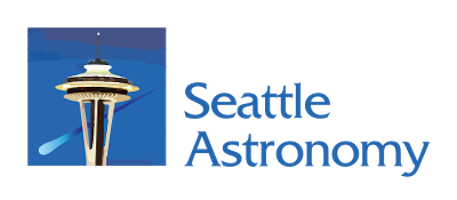Most of us don’t think of Seattle as the capital of anything related to the Sun, and we’re especially grumpy about it in the midst of a relentlessly gloppy March. But Sullivan points out that the second half of our year has long, clear days, and he observes that while people in, say, Phoenix often seek to escape from the Sun, we celebrate it.
“In Seattle, when the Sun comes out you go running out to see your sundial!” Sullivan says.
Sullivan gave a talk titled “Sundials Around Seattle and Beyond: Fascinating Mixtures of Astronomy, Art, Design, and History” at a recent meeting of the Eastside Astronomical Society in Bellevue. While the designation of sundial capital is hardly an official one, Sullivan thinks Seattle is on the way because of its large collection of interesting, well-cared-for public sundials.
 |
| The sundial on a SW-facing wall of the University of Washington Physics/Astronomy building was the first Sullivan helped build and design, 20 years ago. |
“This is what got me into sundials, and ever since my life has been changed,” he says.
Inspired by the design of a sundial at the Sorbonne in Paris, the UW dial is on a wall that faces southwest. That means it’s design is asymmetrical, “which I think is more interesting from an aesthetic point of view,” Sullivan says.
Sullivan notes that all good sundials have a motto, and the one for the UW dial is “What you seek is but a shadow.”
“I thought that was good for a university,” he says. “It feels like it’s making progress.”
In a nod to our northwest weather the dial also is inscribed with a little poem:
I thrive on the SunThere’s a wealth of information about the UW dial on the web, including a webcam.
Can’t work in the rain
So if I’m beclouded
Please come back again.
If you visit a Seattle sundial you will notice that the it doesn’t agree with your watch.
“Sundials do not tell you clock time,” Sullivan explains. “Your watch is off because we keep the same time as the people in Spokane. That ain’t right! Solar noon”—the moment when the Sun is due south and highest in the sky—”happens there 20 minutes before it happens here.”
 |
| Sullivan helped design pancam calibration targets like this one that also serve as sundials on the three rovers on Mars. |
In addition to all of those here on Earth, Sullivan also helped design three sundials that are now on Mars. The rovers Spirit, Opportunity, and Curiosity all have targets that are used for color calibration of their cameras in light and in shade. Bill Nye the Science Guy, who is now CEO of the Planetary Society, saw a mockup of the target, a disk with a post in the middle of it, and immediately thought it should be a sundial. Nye got Sullivan involved in the design. Coincidentally, Tyler Nordgren, astronomer who keynoted the Seattle Astronomical Society‘s annual banquet in January, was also part of the team that put it together.
 |
| Woody Sullivan brought a variety of small sundial samples to his talk, and the conversation continued well past the end of his formal presentation. |
Sullivan’s talk was tremendously well received. One EAS member noted that she switched her scheduled night at the opera to be at the talk instead. Staff at the library at which the talk was held booted us out well after closing time, and even at that the discussion continued in the parking lot for a good 45 minutes more.
Check out Sullivan’s sundial trail website for a guide to visiting Seattle sundials.
Other reading:
- Seattle Times story about the sundial in Sullivan’s home study
- Planetary Society explanation of the face of the Mars dials
- Astrobiology Magazine interview with Sullivan
